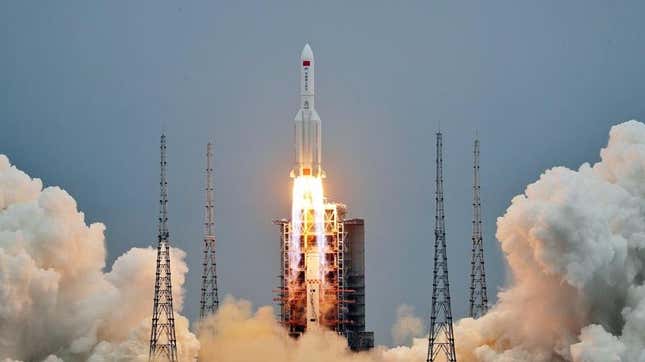
China launched its third and final module of its space station on Monday, moving closer to completing its ambitious project in low Earth orbit to rival the International Space Station (ISS).
The lab module was encapsulated in a Long March 5B rocket, which lifted off from the Wenchang Spacecraft Launch Site at 3:27 a.m. ET on Monday, according to local media reports.
The 23-ton Mengtian module (which translates to “Dreaming of the Heavens”) will rendezvous with its sister modules Wentian and Tianhe in low Earth orbit to form the T-shaped structure of China’s three-module space station named Tiangong (meaning “Heavenly Palace”). The first module of the space station, Tianhe, launched to orbit in April 2021, while Wentian followed more than a year later in July 2022.
Mengtian will dock with the forward port of Tianhe, the core of the space station, and a robotic arm will later relocate it to the port side of the Tianhe module, according to Everyday Astronaut. In June, China sent a crew of three astronauts to the space station to oversee the docking of the two modules. The crew is expected to return to Earth in December, after which point the Shenzhou-15 crew will take over.
The Chinese National Space Administration (CNSA) will use the Mengtian lab to conduct various microgravity experiments related to fluid physics, combustion science, and space technology, according to China’s state-run news agency Xinhua. Unlike Tianhe, Mengtian does not include living quarters for astronauts.
The Tiangong space station is China’s answer to the ISS, even though it’s about a quarter of its size. China is hoping to have its space station fully constructed by the end of the year, and keep a constant flow of astronaut crews aboard Tiangong to conduct various experiments.
China’s space agency is making headway with its space program, with future missions planned for the Moon and Mars. However, CNSA hasn’t been careful in where debris from its rockets land after they reenter Earth’s atmosphere. This past August, debris from the Long March 5B fell across regions in northern Borneo, and previous incidents have taken place in 2020 and 2021 in which debris from the 100-foot-long (30-meter) core stage crashed along the western coast of Africa and the Indian Ocean.
This time around, the core stage from the Long March 5B that lofted the Mengtian module to orbit is expected to make an uncontrolled reentry through Earth’s atmosphere upon its return. It’s not yet clear where pieces of it might land, but this type of free-fall can be hazardous to populous areas below.
More: NASA Lacks Plan for Ditching Space Station in an Emergency